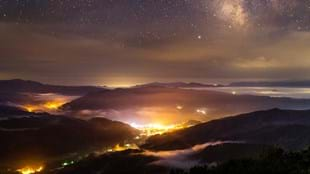For billions of years, life on Earth has relied on the rhythms of day and night. They are embedded in our circadian rhythms, in the DNA of plants, insects, animals, even bacteria. But then we got electricity and there was light, lots and lots of light. Light from our homes and businesses, car lights, street lights, stadium lights, illuminated billboards and tiny screens. We might live in environmentally conscious times, but how often do you think of the impact of anthropogenic light pollution?
If you have ever looked up at the night sky a long way from any town or city you may have been startled by the sight of so many stars. You wouldn’t be alone. According to a research article published in Science Advances in 2016, a third of humanity is living with so much light pollution they can’t see the Milky Way, including 60 percent of Europeans and nearly 80 percent of North Americans. In short, many of us are missing out on something magical, which has occupied the human imagination for millions of years.
“Most of the world is affected by this problem, and humanity has enveloped our planet in a luminous fog that prevents most of Earth’s population from having an opportunity to observe our galaxy,” write the paper’s authors. “This has a consequent potential impact on culture that is of unprecedented magnitude.”
There are health as well as cultural implications. In humans, light suppresses melatonin, the hormone we produce at night in order to sleep. While these effects might be relatively small from night to night, continuous chronic circadian sleep disruption could be leading to longer-term health risks, including cancer. This is most apparent among shift workers; in 2007 the World Health Organization listed circadian disruption resulting from shift work as a probable carcinogen. Circadian disruption has also been linked with headaches, anxiety, medically defined stress and a decrease in sexual function.
It’s not all about us though. The way we light the night can cause birds to sing at the wrong time of day, to migrate at the wrong time of season and head off in the wrong direction, to die after colliding with buildings and towers after being attracted to the lights. Turtle hatchlings are another well-known casualty; when they emerge from their nests they find their way to the ocean by moving away from the dark silhouette of dunes and vegetation, but artificial lighting can send them off track. A 2012 study of leatherback turtles on the Caribbean Island of Tobago found that artificial lighting of the nesting beaches was the biggest threat to the survival of hatchlings and a major factor in declining leatherback turtle populations.
We’re only beginning to understand the impact that all that light is having on the ecological environment and on us. What makes it worse, is that much of it is wasted light and a waste of energy.
“Twenty percent of electricity consumption is for lighting, and at least 30 percent of that is wasted,” says Richard Stevens, professor in the school of medicine at the University of Connecticut. Stevens was recently interviewed for Fit Planet on the importance of circadian rhythms, and the detrimental effect on human health when those rhythms are disrupted by too much light. “Not just human health is being affected – the impact on all other life forms is tremendous.”
It’s also, he says, a significant contributor to global warming. “With all the electricity from fossil fuel combustion being used to put photos in the sky that are totally wasted.”
We have the technology to do something about this; we just need to use it. “The fact is that much outdoor lighting used at night is inefficient, overly bright, poorly targeted, improperly shielded, and, in many cases, completely unnecessary,” states the International Sky Dark Sky Association (IDA) on its website. Much of the light and the electricity used to create it, it says, is being wasted by spilling into the sky, rather than being focused on the actual objects and areas that people want illuminated.
What can you do about light pollution?
You could start by only using lighting when and where and when it’s needed. Turn the lights off in the rooms you’re not using, and close the blinds or pull the curtains to keep the light inside. You could think about whether your outdoor lighting could be polluting the night with lights that you think deters burglars but probably isn’t, and interfering with your neighbors’ circadian rhythms. This is known as “light trespass”; a number of cities in the US have developed standards to protect the rights of their citizens against it. Actually, there’s no good evidence that lighting reduces crime, but if it does provide you with a sense of security, then shield your security lights, or add a motion sensor so it’s activated only when needed.
The IDA website includes numerous educational resources as well as consumer guides for or those keen to help protect the night skies. That includes a database of outdoor lighting fixtures it has certified as “dark sky friendly” under its own Fixture Seal of Approval program.
It also has recommendations for the best types of light (it recommends warm light for outdoor lighting) and has compiled a LED lighting guide to help lighting designers and public officials understand and reduce the impact of this very modern and powerful form of lighting. LED lights might be transforming the way we light urban environments, but they often include large amounts of blue-rich light, which brightens the night sky more than any other color of light and has been shown to be hazardous for human health and wildlife.
In other words, we need to think and talk more about light. As Stevens argued in a paper published in the Royal Society’s science journal, Philosophical Transactions, just as technology used to artificially light the night exploded during the twentieth century, more modern technology (a field called ‘photonics’) is making it possible to light up our world more efficiently, with less waste, “and to better accommodate circadian physiology of life forms in general, but notably of the species directly responsible for the pervasiveness of light at night, which would be us.”
If you want more tried, tested and true news from the leading edge of health and fitness sign up to get insights and advice straight to your inbox.







